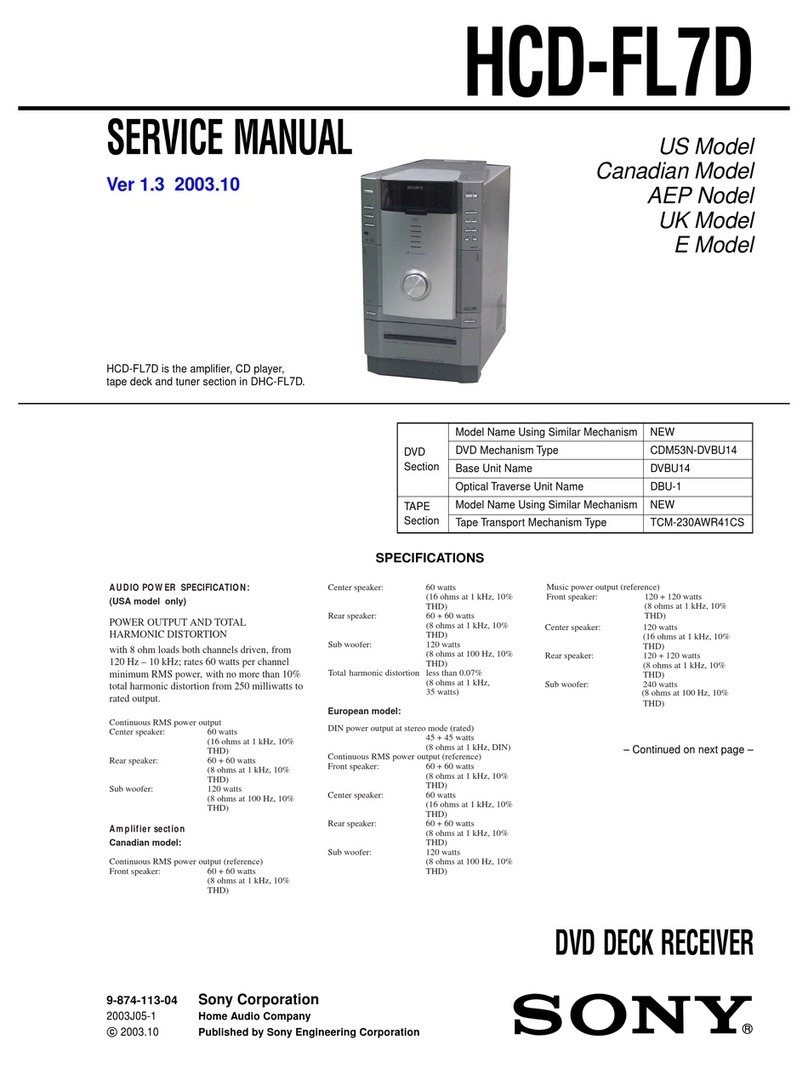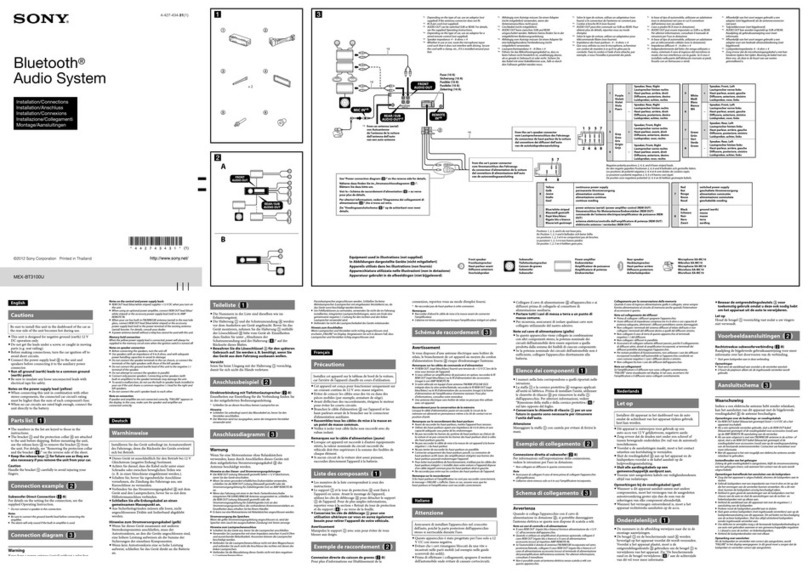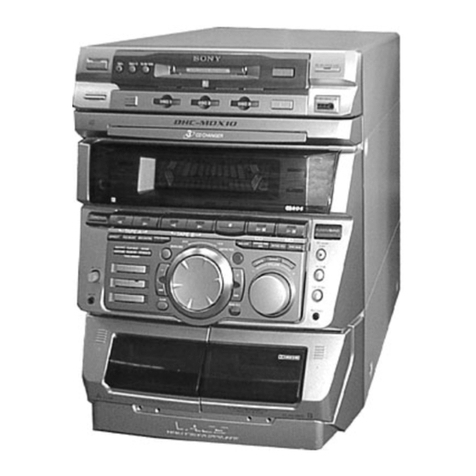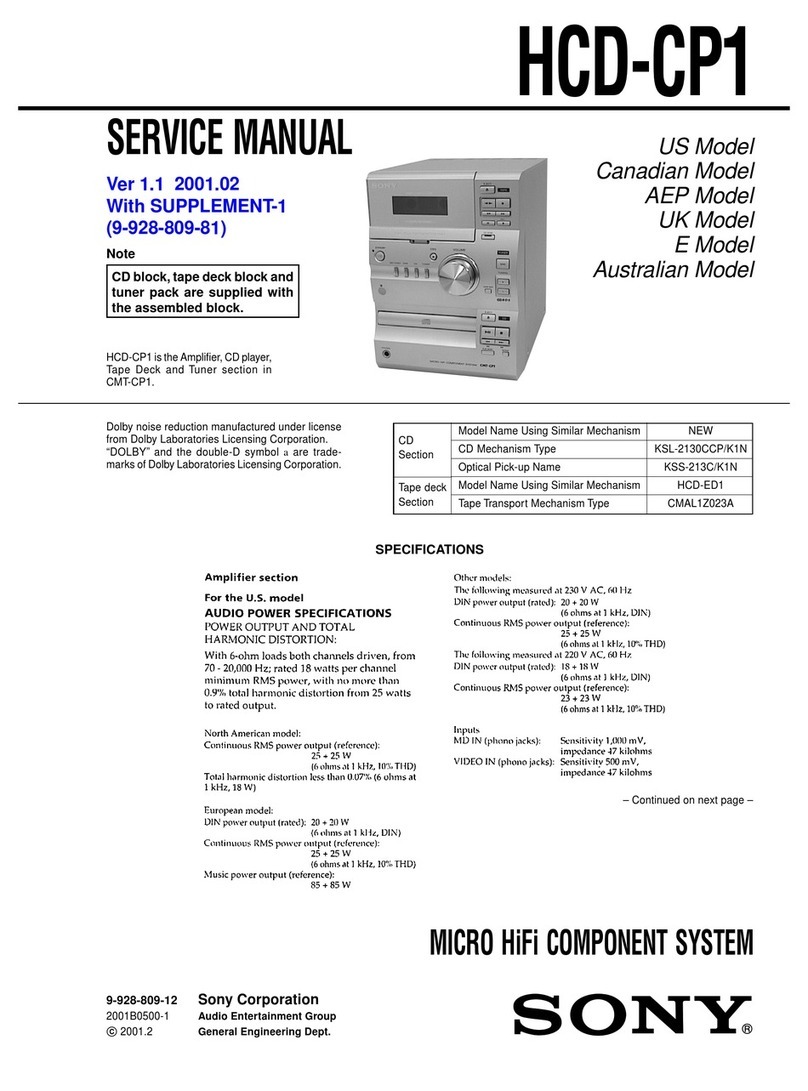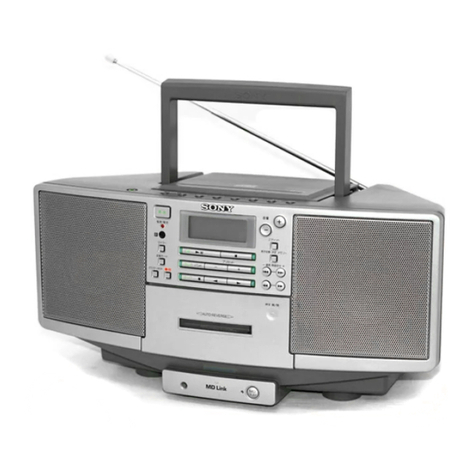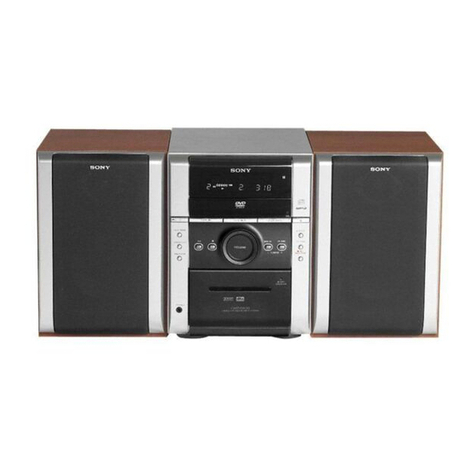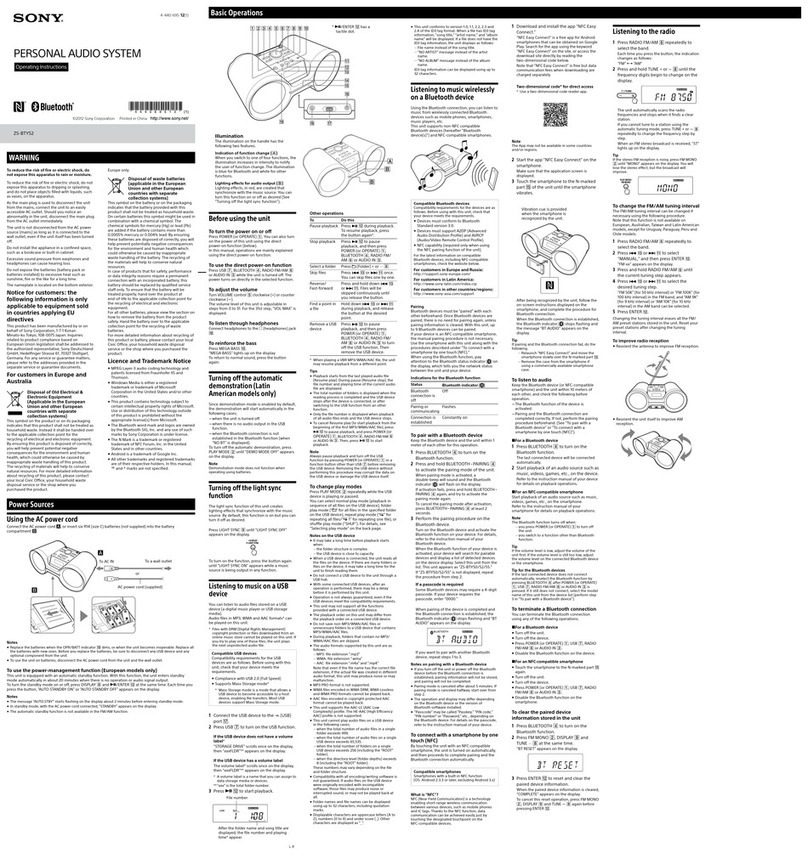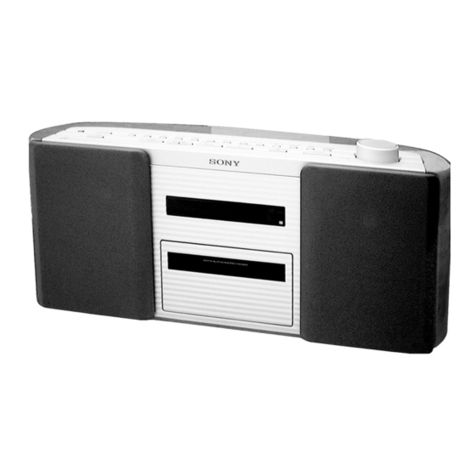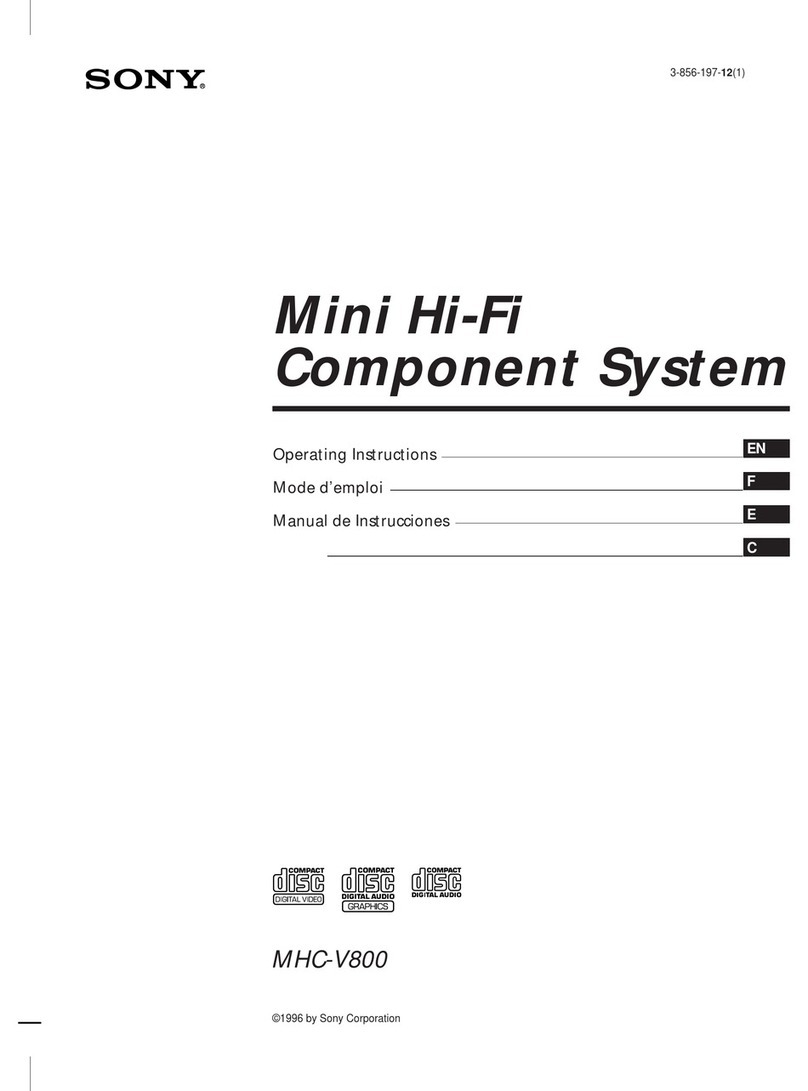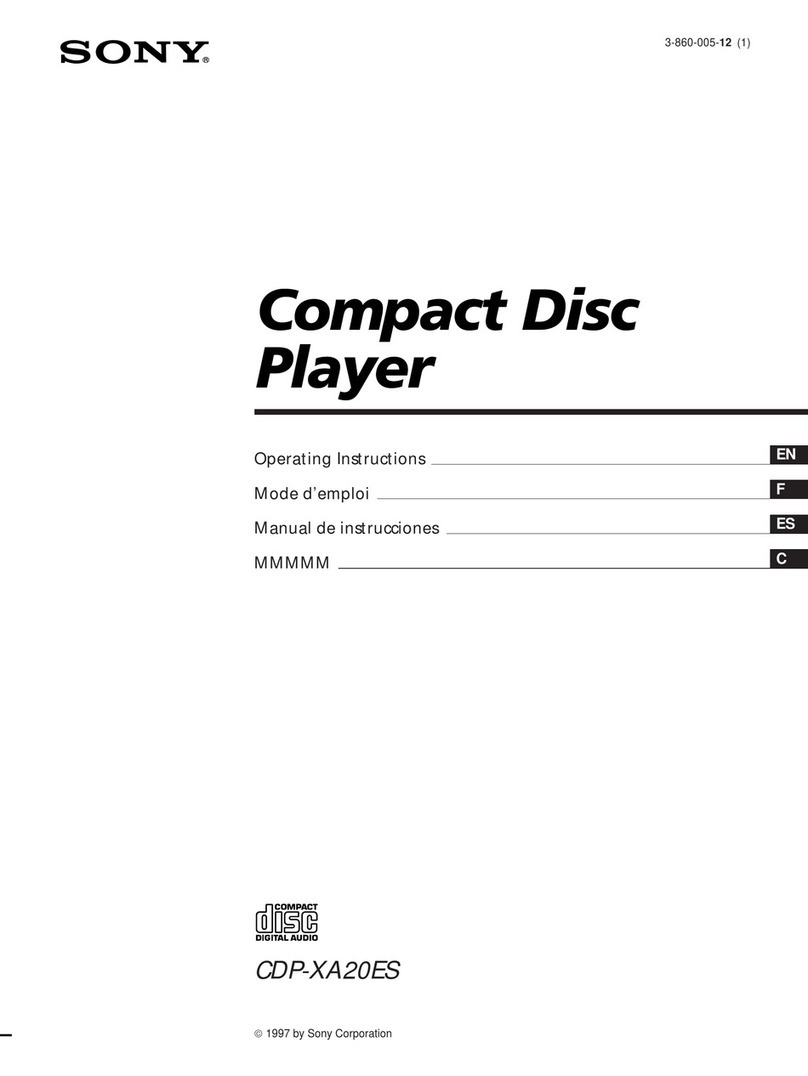
2
HCD-NEZ3/NEZ5
Notes on chip component replacement
•Never reuse a disconnected chip component.
•Notice that the minus side of a tantalum capacitor may be
damaged by heat.
Flexible Circuit Board Repairing
•Keep the temperature of the soldering iron around 270 ˚C
during repairing.
•Do not touch the soldering iron on the same conductor of the
circuit board (within 3 times).
•Be careful not to apply force on the conductor when soldering
or unsoldering.
CAUTION
Use of controls or adjustments or performance of procedures
other than those specified herein may result in hazardous radiation
exposure.
SAFETY-RELATED COMPONENT WARNING!!
COMPONENTS IDENTIFIED BY MARK 0 OR DOTTED LINE
WITH MARK 0ON THE SCHEMATIC DIAGRAMS AND IN
THE PARTS LIST ARE CRITICAL TO SAFE OPERATION.
REPLACE THESE COMPONENTS WITH SONY PARTS WHOSE
PART NUMBERS APPEAR AS SHOWN IN THIS MANUAL OR
IN SUPPLEMENTS PUBLISHED BY SONY.
The following caution label is located inside the unit.
CLASS 1 LASER PRODUCT
LUOKAN 1 LASER LAITE
KLASS 1 LASER APPARAT
This appliance is classified
as a CLASS 1 LASER
product.
This label is located on the
rear exterior.
ATTENTION AU COMPOSANT AYANT RAPPORT
À LA SÉCURITÉ!
LES COMPOSANTS IDENTIFIÉS PAR UNE MARQUE 0SUR
LES DIAGRAMMES SCHÉMATIQUES ET LA LISTE DES
PIÈCES SONT CRITIQUES POUR LA SÉCURITÉ DE
FONCTIONNEMENT. NE REMPLACER CES COM- POSANTS
QUE PAR DES PIÈCES SONY DONT LES NUMÉROS SONT
DONNÉS DANS CE MANUEL OU DANS LES SUPPLÉMENTS
PUBLIÉS PAR SONY.
SAFETY CHECK-OUT
After correcting the original service problem, perform the following
safety check before releasing the set to the customer:
Check the antenna terminals, metal trim, “metallized” knobs, screws,
and all other exposed metal parts for AC leakage.
Check leakage as described below.
Fig. A. Using an AC voltmeter to check AC leakage.
1.5 k
Ω
0.15
µ
FAC
voltmete
(0.75 V)
To Exposed Metal
Parts on Set
Earth Ground
Tape deck section
Recording system 4-track 2-channel, stereo
Tuner section
FM stereo, FM/AM superheterodyne tuner
FM tuner section
Tuning range 87.5 −108.0 MHz
Antenna FM lead antenna
Antenna terminals 75 ohms unbalanced
Intermediate frequency 10.7 MHz
AM tuner section
Tuning range
Pan-American model: 530 −1,710 kHz
(with the tuning interval
set at 10 kHz)
531 −1,710 kHz
(with the tuning interval
set at 9 kHz)
European model: 531 −1,602 kHz
(with the tuning interval
set at 9 kHz)
Other models: 530 −1,710 kHz
(with the tuning interval
set at 10 kHz)
531 −1,602 kHz
(with the tuning interval
set at 9 kHz)
Antenna AM loop antenna, external
antenna terminal
Intermediate frequency 450 kHz
General
Power requirements
North American model: AC 120 V, 60 Hz
Mexican model: AC 120 V, 60 Hz
European model: AC 230 V, 50/60 Hz
Australian model: AC 230 −240 V, 50/60 Hz
Korean model: AC 220 V, 60 Hz
Chinese model: AC 220 V, 50/60 Hz
Taiwanese model: AC 120 V, 50/60 Hz
Argentine model AC 220 V, 50/60 Hz
Saudi Arabian model: AC 120 −127, 220,
230 −240 V, 50/60 Hz
Other models: AC 120, 220 or
230 −240 V, 50/60 Hz
Adjustable with voltage
selector
Power consumption
CMT-NEZ5
European model: 60 W
0.3 W (in Power Saving
Mode)
Other models: 50 W
CMT-NEZ3
North American model: 40 W
European model: 45 W
0.3 W (in Power Saving
Mode)
Other models: 45 W
Dimensions (w/h/d) (excl. speakers)
Approx. 164 ×235 ×
265 mm
Mass (excl. speakers)
CMT-NEZ5: Approx. 3.6 kg
CMT-NEZ3
North American model: Approx. 2.8 kg
Other models: Approx. 3.6 kg
Design and specifications are subject to change
without notice.
CD player section
Laser Diode Properties Emission duration:
continuous
Laser Output: Less than
44.6 µW
(This output is the value
measurement at a distance
of 200 mm from the
objective lens surface on
the Optical Pick-up Block
with 7 mm aperture)
Frequency response 20 Hz −20 kHz
LEAKAGE TEST
The AC leakage from any exposed metal part to earth ground and
from all exposed metal parts to any exposed metal part having a
return to chassis, must not exceed 0.5 mA (500 microamperes.).
Leakage current can be measured by any one of three methods.
1. A commercial leakage tester, such as the Simpson 229 or RCA
WT-540A. Follow the manufacturers’instructions to use these
instruments.
2. A battery-operated AC milliammeter. The Data Precision 245
digital multimeter is suitable for this job.
3. Measuring the voltage drop across a resistor by means of a
VOM or battery-operatedAC voltmeter. The “limit” indication
is 0.75 V, so analog meters must have an accurate low-voltage
scale. The Simpson 250 and Sanwa SH-63Trd are examples
of a passive VOM that is suitable. Nearly all battery operated
digital multimeters that have a 2 V AC range are suitable. (See
Fig. A)
